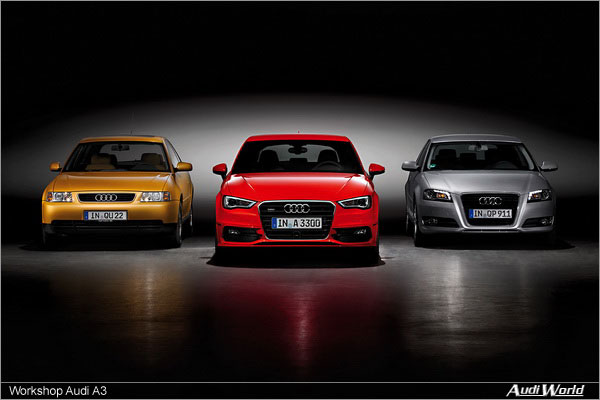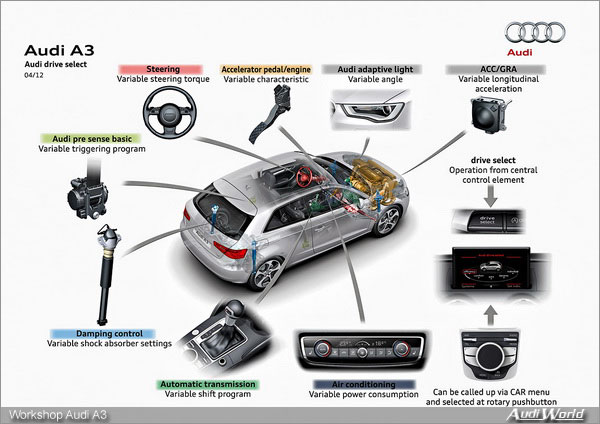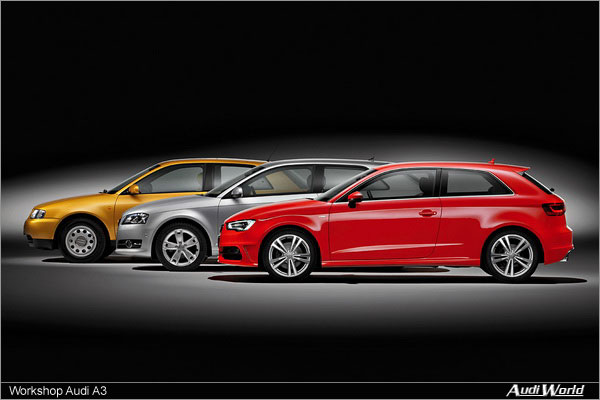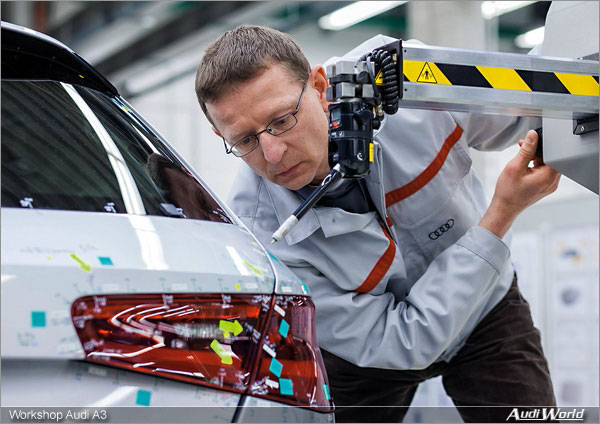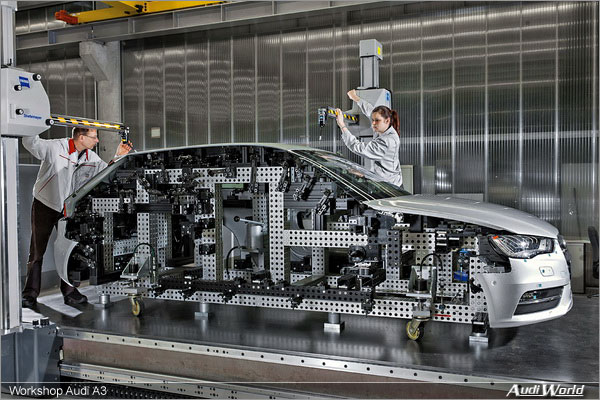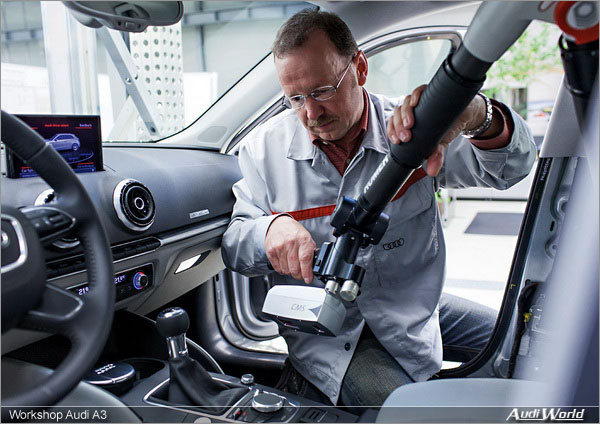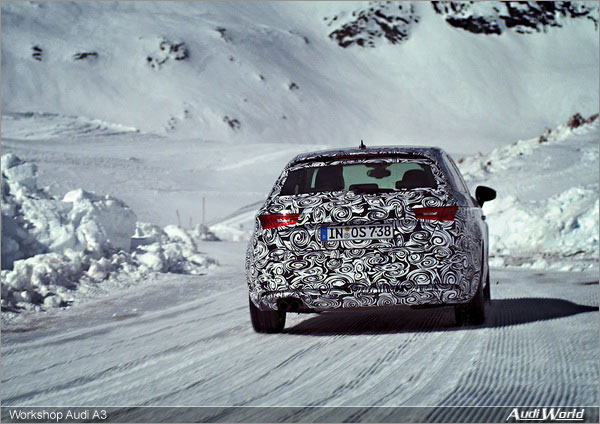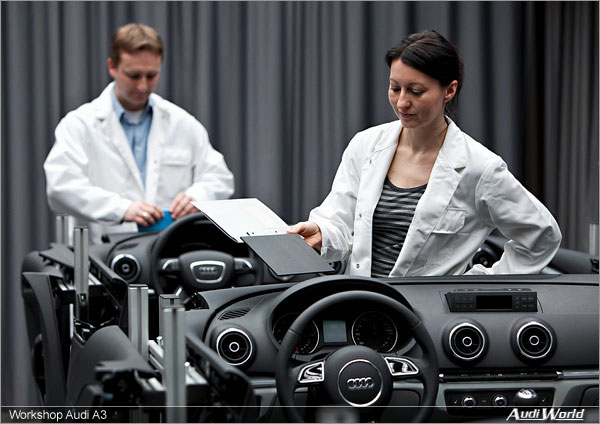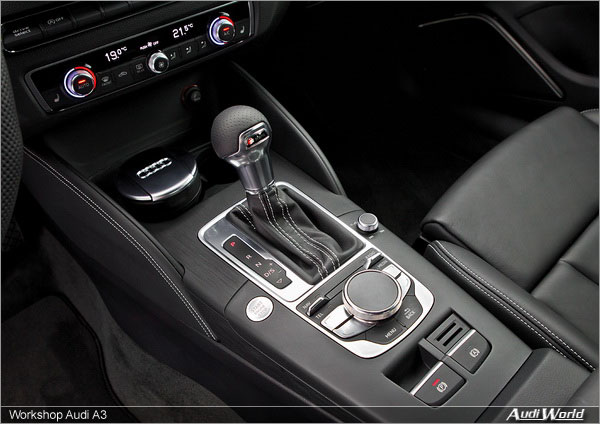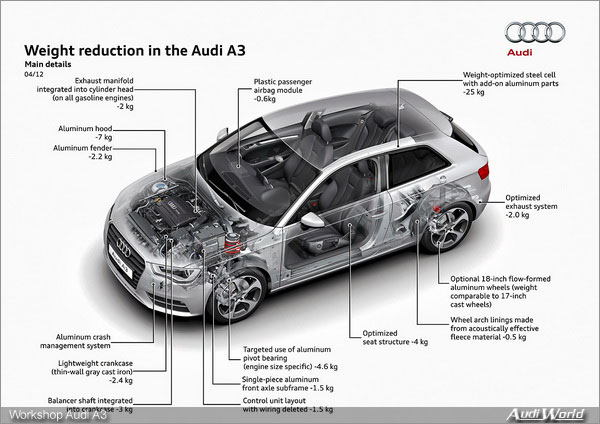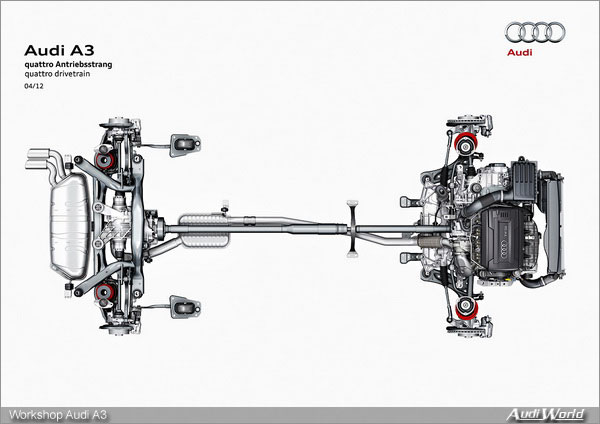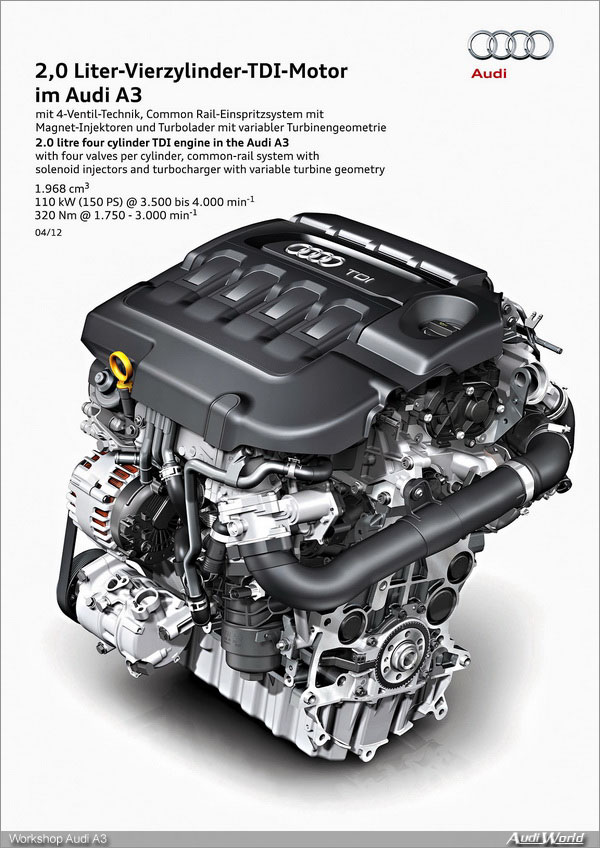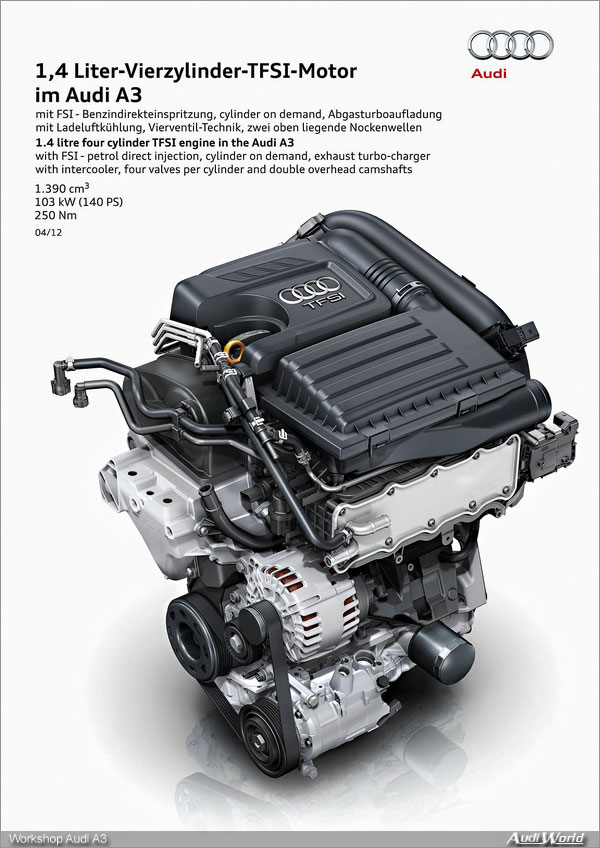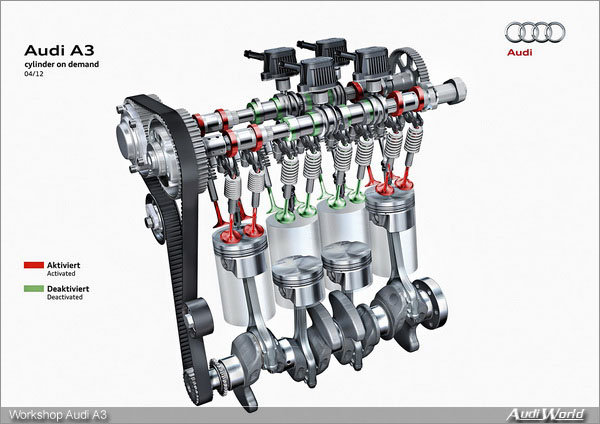Workshop Audi A3
The new Audi A3 showcases Audi’s technical competence in all aspects of carmaking. Ultra lightweight construction methods have resulted in a pioneeringly low weight of the progressively designed premium compact, its engines are powerful and yet highly efficient, and its interior offers an ambiance full of sporty elegance, precision and quality. In its mobile infotainment and driver assistance systems, the car offers technologies that set new benchmarks in this market segment.
The new Audi A3 has a sporty and taut stance on the street. Its athletically sculpted body with a low engine hood, prominent shoulders and sharply inclined C-pillars emphasize its width; each styling element is precise and highly expressive. The new premium compact is 4.24 meters (13.91 ft) long, 1.78 meters (5.84 ft) wide and 1.42 meters (4.66 ft) tall. Its wheelbase has grown to 2.60 meters (8.53 ft), while its front overhang has been shortened accordingly.
The interior continues the light line design of the exterior. A recessed curved piece, the wrap-around, runs the length of the instrument panel. Its construction is lean and low, and it appears to hover at the center console. Large round air vents in jet-engine styling and elaborately sculpted inlays provide decorative accents.
The A3 1.4 TFSI weighs no more than 1,175 kg (2590.43 lb) – the best value in the premium compact class. Compared to the previous model, developers reduced the car’s curb weight by up to 80 kg (176.37 lb) – once again reversing the upward weight spiral and living up to the Audi ultra lightweight construction principle.
The occupant cell of the new Audi A3 was made 25 kg (55.12 lb) lighter. One reason is that form-hardened steels were used extensively. The engine hood and fenders are made of aluminum; together they save over nine kilograms (19.84 lb). Many parts in the chassis and interior also contribute to overall weight reduction – from the aluminum pivot bearings in the front suspension to the blower motor of the climate control system. The entirely new engines that were developed are also exceptionally lightweight.
The new A3 launches with one TDI and two TFSI engines; their displacements range from 1.4 to 2.0 liters and their power from 90 kW (122 hp) to 132 kW (180 hp). All engines follow Audi’s downsizing philosophy, and technologies from the modular efficiency component platform also improve fuel economy. The 2.0 TDI, for example, attains a combined fuel consumption of 4.1 liters of fuel per 100 km (57.37 US mpg).
All engines have the same mounting position in the new A3 – which comes from standardization in the modular transverse platform (MQB). This mounting arrangement and the compact layout of the new gasoline engines have shortened the length of the vehicle’s front end. This let Audi developers shift the front axle forward, which benefits crash behavior and the distribution of axle loads.
Audi is pairing the 1.4 TFSI and 2.0 TDI with a manual six-speed transmission. The seven-speed S tronic is standard equipment in the 1.8 TFSI; the dual-clutch transmission adds a freewheeling function in conjunction with Audi drive select. The quattro permanent all-wheel drive will make its appearance later in 2012, and the engine lineup will continue to rapidly grow – with remarkably efficient, powerful and low-emitting drive systems.
In the areas of mobile infotainment and driver assistance systems, the new Audi A3 offers optional solutions that are entirely new to the segment. Customized online services, which the brand offers under Audi connect, rapidly connect drivers with their surroundings and supply the driver with key information – in an easy-to-comprehend format.
A comprehensive array of optional infotainment components is offered to make use of the new services, in which the top unit is MMI navigation plus. This high-end system impresses with its super-flat, electrically deploying seven-inch monitor and new user control concept, in which MMI touch was integrated in the rotary pushbutton: It has been made into a touchwheel with a touch-sensitive surface.
Audi has developed a wide variety of assistance systems for a comfortable and superior driving experience. They range from adaptive cruise control to Audi side assist and Audi active lane assist to the safety system Audi pre sense basic.
Audi quality knows no compromises – and Audi employees in Quality Assurance help to ensure that this objective is met. A considerable share of the high quality of the new A3 is already achieved in vehicle development. Conformance to dimensional tolerances in body construction, the precision of interior parts, visual coordination of all chrome and colored parts, as well as the analysis of the chemical properties of the materials – all of these areas are core competencies of Audi Quality Assurance.
In vehicle driving trials, many millions of kilometers are driven each year on what are known as function safeguarding trials. When a development project has been completed, Quality Assurance issues a production release for the total vehicle, and it continues to meticulously check the quality of the cars during production.
The progressive design idiom of the new A3 expresses all of the passion with which Audi develops and builds its cars. A sporty-extended sculptural appearance, sharp body shoulder and sharply inclined C-pillar lend the dynamic premium compact its typical character. The taut lines focus on the essential; each element on the new A3 makes a precise and very expressive statement.
The new Audi A3 exhibits compact dimensions. Its length of 4,237 mm (166.81 inches) and height of 1,421 mm (55.94 inches) are nearly unchanged compared to the previous model. However, use of the modular transverse platform (MQB) architecture increased the wheelbase by 23 mm (0.91 inches) to 2,601 mm (102.40 inches), making the front overhang that much shorter – and giving the car a sportier look. The car’s width increased 12 mm (0.47 inches) to 1,777 mm (69.96 inches).
The sporty lines of the exterior are repeated in the interior. Similar to the larger Audi model series cars, a curved piece – the wrap-around – runs across the instrument panel, encircling the driver and front passenger. It is built lean and low and appears to hover over the center console. Large, round air nozzles in jet design and sculpturally molded trim strips serve as decorative accents.
Exterior styling
The headlights are small masterpieces of great technical precision; with their resolute look, they symbolize the character of the new A3. The are styled in a wedge shape; their lower edges are contoured in a slight wave. In the optional xenon plus module, the LED daytime running lights form narrow, visually uniform borders of lights at the upper and lower edges, which suggest the shape of an eyebrow. The turn signal lights are at the pointed corner of the headlight behind the “wing” – a narrow, chrome-plated fin, which is a typical Audi feature inside the light module.
The side view expresses the athletic power of a trained athlete; its proportions visualize the emotional character of the new Audi A3. The car’s front end is built low, the roof arch forms a stretched dome, and the trapezoidal, sharply inclined C-pillar sets the rear section powerfully over the rear wheel. The ratio of metal surface area to windows is two-thirds to one-third – a typical proportion for Audi.
The sharply drawn tornado line visually presses the new A3 firmly onto the street. Beginning at the headlights, it extends in a curve over the fenders, doors and side panels to the tail lights. The tornado line gives the body shape strong shoulders and forms a pronounced, broad shadow edge, especially above the wheels. Above the side sills there is the dynamic line that sweeps back energetically towards the rear of the vehicle with an upward ascent.
Fine details accentuate the styling. Like on a sports car, the exterior mirrors are placed on the upper door panels, and the bow-shaped door handles convey a rugged image. Wide, sculpturally flared wheel housings create space for sporty wheels. On the Ambition and Ambiente lines, they are 17 inches in diameter; 18-inch wheels are also available as an option. Tire sizes are 205/55, 225/45 and 225/40.
At the rear, the new Audi A3 is intensively shaped; the split tail lights, which extend inward into the trunk from the side panels, emphasize the car’s width. Light conductors fed by LEDs light up in flat, uniform curved shapes in the dark; the turn signal lights continue the contour on the upper border of the tail lights. The new A3 has either one or two tailpipes on the left side of the diffuser insert, depending on the engine.
The S line exterior package further sharpens the visual appearance of the premium compact. Diamond-pattern screens fill the large air inlets, which are bordered by powerful edges. Suggested air inlets create sporty accents on the front fenders. The sills have distinctive add-on strips. The roof edge spoiler has been lengthened, the bumper has an additional edge, and the diffuser integrates a diamond-pattern insert.
Interior styling
The instrument panel is styled like a wing profile. Because the central module for the infotainment systems has been moved to the glove box, the panel has a lean and low construction – it appears to hover over the center console, slightly inclined towards the driver. Located at its center are control buttons for secondary functions; they are styled to appear like traditional rocker switches.
The center tunnel console, framed on both sides by the high-drawn knee pads in the style of the TT sports car, presents a clean, well-organized look. Thanks to the new electromechanical parking brake, there is no longer any brake lever; this has created space for the terminal of the optional MMI navigation plus system. The armrest is adjustable in length and height.
The newly developed front seats offer excellent support and motion control; they are mounted low, in keeping with the premium compact’s sporty character. The sport seats (standard in the Ambition) offer numerous adjustments – the precisely executed seam pattern on the seats reflects the high level of quality in the Audi A3. The driver sits behind an elegant restyled steering wheel. Depending on the version, it has either three or four spokes and a flat bottom, it also has shift paddles and multifunction keys that are framed by delicate chrome trim.
Many elegant details create interior highlights. The four large, round air nozzles in classic jet design reflect technology aesthetics as interpreted by Audi. Their air flow is adjusted by pulling on the central axis – this adjusted the air flow from broadly dispersed and draft-free to a focused stream. When the rings are turned, they give a fine precisely-defined click, the sound of technical precision.
With their elaborate grooves, consisting of numerous tiny pyramidal shapes, the rings have a high level of tactile quality. The same pattern is also found on the large MMI wheel, the audio volume dial and the controls for the climate control system. Its controls, with white, blue and red illumination, are embedded in a panel with black piano paint look.
Another highlight: the molded three-dimensional decorative trims on the front of the instrument panel and in the doors. As an option, they are available in aluminum or 3D-design “Optic”; in the latter, a new type of multilayer surface construction gives the impression of astonishing visual depth.
The colors and materials of the interior of the new A3 are laid out differently, depending on the equipment line – Attraction is the contemporary, Ambition the sporty and Ambiente the luxury version. Audi styles the interior in black and titanium gray; fresh accents in pashmina beige, chestnut brown or capri orange can be added as options. The S line sport package offers exclusive details and a black look throughout. The Audi design selection option capri orange, on the other hand, represents a new, highly contemporary color scheme.
As an optional feature, the seat covers are available in various leather qualities or in a leather/Alcantara version. Of special interest here is the new Velvet leather, a complex dressed type of leather. Special processing gives it a rugged, slightly rough surface similar to that of suede leather.
Audi’s leadership role when it comes to quality is continually being reaffirmed in surveys, competitions and analysis. It is based on the fact that at Audi quality is not just a company goal, it is a permanent aspect of its corporate culture. It is an attitude and mode of thinking, which is of course firmly established in Quality Assurance, but is equally practiced in all other areas of the company. The central focus here is always the customer; what drives us is the goal of delighting the customer time and time again – this is the challenge we set for ourselves.
The employees of Quality Assurance are involved early in the development process, even while initial sketches of a new vehicle are still being made. They offer input on concepts and work together with Design in the selection of materials. That is, Quality Assurance continually supports the entire development process – always driven by the goal of implementing what has been learned, letting experience flow into the process and perfecting the product in its creation phase. That is because early actions are the best way to avoid late changes, and as Werner Zimmermann, Head of Audi Quality Assurance, says: “To save on quality is always the most expensive solution.”
Countless laboratory tests in the qualification and release of new materials, components and production processes reflect the high standards that Audi sets for itself. In this process, the most advanced analytical methods are applied, such as computer tomography, but this process always involves people as well.
Touch, odor, color impression – these sensory perceptions are what always counts here in addition to measuring instrument findings, because quality can be seen, sensed, smelled and heard. As impressive as the measured values may seem to be – if the sensory perception is not right, then the quality is not right for Audi either.
At Audi, quality is not only an attitude and way of thinking – it is also a management priority. Quality Assurance, which employs over 2,000 people, assumes the role of a neutral party within the company. It reports directly to the Chairman of the Board. Weekly reporting and short organizational paths to the highest decision-making levels ensure that quality is always a focal topic of interest and that decisions can be made quickly and with sustained impact. This strong position guarantees that Audi Quality Assurance can fulfill its role – without restrictions – as the “advocate of the customer” within the company.
“Quality means continually raising the bar a bit higher – that is what defines Audi.” Once again, the new Audi A3 is proving out this philosophy. It sets new benchmarks in its class, especially in the interior, with regard to its styling impression and material selection.
High-end surfaces, complex accents, the customary perfect fit of components, painstakingly tuned actuating forces and full acoustic and tactile feedback of controls – all of these define the new A3 together with the additional supplemental new functions and features such as virtually draft-free air vents, a retractable monitor that is unique in this vehicle class, MMI touchwheel and numerous new infotainment and assistance functions.
These features are is all packaged within a sheet metal skin that redefines the limits of sheet-metal forming with its intelligent material mix of various steel and aluminum alloys. Well-defined edges, small radii and once again the perfect fit of components – this is the Audi quality that our customers have come to appreciate and expect.
New, more efficient engines, highly advanced assistance systems and infotainment technology from the luxury class must all prove their reliability – even in the compact class.
The A3 has been driven a total of 11.2 million kilometers (6.96 million miles) in 10 countries. Its reliability has been put to the test under extreme conditions – in the heat of the Mojave desert and in the extreme cold of Scandinavia. The new efficient engines were subjected to extreme loads on the German Autobahn as well as in the stop-and-go traffic of Chinese megacities, and they have proven themselves.
Customer-oriented validation on public streets gives models from Audi their finishing touches, because this process further refines car details long after their functionality has been put to the test by Development. Only after all of these optimizations have been completed does Quality Assurance recommend release of a new product.
At Audi, the master jig is the main instrument used by Quality Assurance to attain a premium impression and perfect fits.
The task of the exterior master jig is to optimize and fine-tune dimensional fits on every vehicle project before a production launch. This involves coordinating the fits of all parts that are visible on the exterior with one another. These parts range from sheet metal panels such as doors, engine hoods and trunk lids to exterior trim parts such as bumpers, headlights, taillights, windows, mirrors, door handles, spoilers and decorative trim strips. The measurement and analysis fixtures of the exterior master jig are housed in a dedicated building together with the interior master jig.
Other tools – which are also fundamental to successful coordination – are used in this area before work is performed on the exterior master jig.
The joint master jig is used to check for dimensional conformity of the underbody and its individual components, such as the front and rear floors and to coordinate them to one another. It ensures that all components can be joined without stresses. This is necessary to be able to produce a high-quality body in the later production process, which is the foundation for the premium image of Audi vehicles.
Using what are known as exterior function cubes, experts analyze the vehicle’s exterior trim parts in a local zero-reference environment. Correction data is derived from this process, which is used to optimize components at an early phase. When they fit to the cubes, they are added to the exterior master jig for further fine tuning.
Work in the zero-reference environment of the exterior master jig begins about nine months before production launch. Previously inspected panel parts of the body’s exterior skin and the parts mounted to them, such as doors and hoods and lids, are built up on a frame constructed of solid aluminum profiles. Exterior trim parts are also added to the assembly to analyze the interplay of all body parts.
This gives specialists a stepwise method for perfecting the dimensional tolerances of parts, achieving flush fits and perfecting the lines of joints.
An additional fine-tuning step involves working with reference bodies that are equipped in a way similar to that of an exterior master jig. This is done so that the paint application can also be considered in a final fine-tuning step. Although the paint is only as much as 15 hundredths of a millimeter (0.04 inch) thick, by Audi’s way of thinking, even this plays a major role in dimensional optimization.
The seam pattern on the new Audi A3 does not always follow exact mathematics; in some zones, subjective impressions are also considered in the tuning process. Take the front bumper, for example, which is slightly offset to the rear at its transition to the fender so that the customer always perceives a harmonious transition when looking at it from above. Another example: the seams at the fuel filler door. The upper seam was intentionally made smaller than the lower one, to give the subjective impression of a better fit for the observer.
Along with dimensional conformity, the exterior master jig also yields information on color fidelity, gloss level and the tactile feel of sheet metal, aluminum and plastic parts. In addition, it provides information on the firm seating of all components and their easy assembly and whether optimization potential exists in the component concepts.
Audi specialists are always faced with exciting new challenges in their work at the exterior master jig – challenges they must overcome to fulfill stringent requirements for the overall impression of the vehicle’s exterior.
Different materials such as steel, aluminum, plastics, rubber and glass must be cleanly fitted to one another. The overall impression is only distinctive and high-end if all edges and their radii fit precisely to tenths of a millimeter; only then is the run of the tornado line from the fender over the door to the side wall frame pleasing to the eye.
No rattling or creaking, and exact fits: Audi also places high value on maximum precision in its cars’ interiors. Serving as the reference at Quality Assurance is what is referred to as the interior master jig – a body produced to a specific design level that does not exhibit any deviations at the points where interior components are mounted. Ten months before production launch, the components are coordinated and fitted to one another using optical and tactile measurement methods.
Along with verifying functional criteria – free movement of parts, firm seating, ease of installation, harmonious actuation forces and sounds – the primary focus of measurement work with the interior master jig is on visual properties. All parts are inspected for grooves, voids and blisters. Special attention is given to checking of seams, e.g. on the centre console that is made up of numerous individual components – from knee pads to the MMI terminal.
Even the smallest of details are given full attention on the interior master jig at Audi Quality Assurance. Whether the checking relates to minimal burrs on the defroster outlets or a visually uniform border along the grid perforations of a loudspeaker cover – even such minor shortcomings are discussed with suppliers and corrected.
The four air nozzles in jet design at the front of the cockpit are highly complex parts. Each consists of over 30 individual components. Allowable tolerances are on the order of a few hundredths of a millimeter in the design feature for adjusting the air stream to spot mode or diffuse mode. Therefore, the supplier assembles and checks every part in a 100 percent automated process – here the brand with the four rings is once again raising the quality bar a bit higher.
A parts that helps to ensure optimal sitting comfort is the center armrest with its height and length adjustments. A high-quality aluminum die cast body with a two-component material joint ensures full adjustment acoustics.
Another highlight in the Audi A3: the three-dimensional decorative trim strips in the doors – they are embedded in a soft film without any gaps. The complex mounting feature on the rear side was not released in the internal master jig process until it was perfectly tuned to assure an elegant impression and no noise.
The decorative ring on the gear shift grip is embedded with a precision of just a few hundredths of a millimeter to assure perfect tactile feel for the driver.
Audi has even implemented elaborate solutions in the luggage compartment of the new A3: when the cargo floor is folded upward, spring-loaded plastic latches hold it in place for the customer.
Special cubes are used to check the fits of functionally relevant vehicle subassemblies. In the doors of the new A3, quality experts were not satisfied until pleasant-sounding window tracking and door closing acoustics were assured under all conditions. This was technically implemented by features such as “post-tracking,” in which the window slides into the window guide starting at the front. Only then did the window seal perfectly on the roof profile of the window guide with a constant insertion depth. Another focal point was the double seal between the door and the body. A continuous seal was attained with the help of color imprint methods and optical measurement technology. Only with this high level level of precision could the stringent quality requirements for closing noise, closing comfort and interior acoustics be met.
On the interior master jig, specialists also ensure that the door trim has precise, uniform gaps in its transition to the body door to ensure noise-free operation over the entire life of the vehicle at the customer. A new fastening concept with a flocked stop rail was coordinated and implemented.
The master jig is the main instrument on which the last quantum of perfection and precision is extracted from the parts. It is a key component within Audi Quality Assurance. This is where all participants – in-house engineers and specialists from suppliers – can check the progress of their development projects. Members of the Board of Management are also regular guests at this facility, because at Audi quality is a top management priority.
Before Audi Quality Assurance and the Board of Management issue a total vehicle release for production of the new A3, what is known as the function safeguarding trial is performed with cars from the test and pilot series. The goal is to thoroughly check all aspects of the car that could potentially lead to complaints when they reach customer hands.
The function safeguarding trial begins about a half year before the production launch, provided that all parts – manufactured from production tools – and the software of the new car are available. This leaves enough time to resolve problems with their colleagues from Technical Development and Production.
In the function safeguarding trial, Quality Assurance employees drive about 600 pre-production vehicles in everyday driving over 50,000 km (31,068 miles) or 100,000 km (62,137 miles) annually. They are driven on public roads under the same conditions that customers will experience later on. In this testing, besides checking practical aspects of the design, the experts check the level of component quality as well.
Many different types of drivers participate in the function safeguarding trial – low-mileage and high-mileage drivers, women and men, young and old, tall and short, sporty drivers and more reserved drivers. They record their general impressions and evaluate special attributes in all vehicle areas. This encompasses such aspects as forces to move the steering wheel and pedals, the feel and acoustic behavior of controls and the functionality of roof carriers, auxiliary heating systems and trunk unlocking. Infotainment and driver assistance systems are playing an increasingly greater role here.
The function safeguarding trial is conducted in Germany as well as in foreign countries and different continents – under extreme conditions in many places. In Singapore, for example, air humidity is usually very high; here condensation water can elicit functional problems. In Beijing, on the other hand, the focus is on components that are particularly stressed in stop-and-go traffic – the parking brake, clutch, thermal management and horn, for example. Another issue in China is the quality of available fuel.
In interior regions of Asia, the streets and mountain roads stir up a lot of dust, which can damage mechanical parts like window lifts. The bitter cold prevailing in northern regions can cause plastic parts to become brittle and grate, and electronic control modules may start up slowly. Dry, fine-grained snow is also capable of plugging up induction air ducts to the engine; therefore, Audi installs special screens for cold countries.
In export countries, local drivers take the steering wheel in the framework of the function safeguarding trial – they input typical driving habits and expectations of the local region into the evaluation. Chinese drivers, for example, generally shift gears early, while US customers use the air conditioning more intensively and value cup holders more. Russian customers, on the other hand, appreciate a quickly responding heating system highly.
The work of Quality Assurance – Total Vehicle does not end at the production launch – it continues into the production process. Until production runout, employees regularly audit vehicles from ongoing production for their quality, including in foreign plants. When important technical innovations make their way into production, they are first validated in specially designed test programs.
Members of the Board of Management conduct their own evaluation drives on a regular basis – top managers at Audi possess a great deal of expert know-how. The proverbial “gasoline in the blood” and passionate discussions about the character of each individual model have become engrained in the brand’s business culture. After a final acceptance drive, the production release for the total vehicle is official issued.
Even before the function safeguarding trial, what is referred to as the function safeguarding process is started at Audi; here the primary focus is on electronic and electrical systems, such as the new infotainment system in the A3. An expert team from the Development and Quality Assurance areas takes to the roads in specially configured vehicles. One goal is to uncover any defects in the electronic control modules and their networked communications.
The cars in the function safeguarding process have complex on-board test instruments that are powered by a separate battery. In teams of two, the driver and passenger work through special functional checklists – from opening and closing the windows to altering the navigation destination. While doing this, they observe the general behaviors of systems and components. In background, the measuring equipment documents available data for later use in error analysis. The great efforts that Audi invests in the function safeguarding process and the function safeguarding trial serve one purpose – quality in the service of the customer.
In Material Technology’s chemical laboratory, all types of materials (oils, greases, operating materials, polymers, metals), components and entire vehicles can be studied by a wide array of analytical methods. In all vehicle projects, the analysis team is involved early in the development process. The laboratory supports Technical Development in selecting materials, especially with regard to such aspects as processing, emissions, hazardous materials and aging behavior over the product’s life. Material types often need to be optimized, because when geometries are modified, this can result in manufacturing parameters exceeding a material’s functional limitations.
In other cases, materials selected for interior vehicle parts may emit vapors that emit unpleasant odors or potentially hazardous chemical substances, which would render a material unfit for use in the interior. Even emissions of noncritical materials may prevent the use of certain materials, because they emit components that are deposited on the windows as a tough, visible layer – also known as fogging.
To analyze these substances, the parts are stored in a heated chamber at a defined temperature and air humidity, and air samples are then taken from the chamber and analyzed by a wide variety of qualitative and quantitative methods (including mass spectrometry, gas chromatography and liquid chromatography).
Development projects for transmissions and engines are supported by special operating material analyses, which are able to characterize the properties of a material as well as its wear and thermal decomposition behaviors.
Metallurgical analysis helps to explain such issues as part wear. If metal components are exhibiting unusual wear behavior, the reasons may lie in the alloy composition. A precise determination of the composition can be made by combusting material samples in plasma gas and conducting a spectral analysis of the resulting flame; the findings can either confirm or reject a material cause.
What appears to be an incomprehensible chemical labyrinth to the lay person is indeed a highly complex yet clearly defined field to experts at Quality Assurance. In their work, they ensure that materials with problematic components or questionable reliability do not make their way into vehicles.
The interior of the new Audi A3 integrates about 150 colored components; customers can choose from five color schemes. Whether it is pashmina beige or titanium gray – one requirement is always the same: All parts, from decorative trim strips to the carpeting, must be precisely matched and coordinated. Audi Quality Assurance coordinates them all and resolves any issues with suppliers.
The colored parts in the A3 interior are extremely diverse. They consist of 34 different types of semi-finished goods – such as fabrics, leathers and films – and ten types of plastic; they come from 45 suppliers across the globe. This broad variety of materials results in many difficult neighboring interactions. For example, when smooth plastic meets textured surfaces, such as in the area of the center console, the different reflectance values of the materials can generate different, undesirable colors as perceived by an observer.
Special pigments are necessary to dye parts with different material chemistries in the same color hue. All components are dyed through, and many are also painted – some with high-gloss paint. In the new A3, for example, high-gloss components include the control panel for the climate control system and the frame of the MMI monitor. UV-stabilizers in the plastics prevent colors from bleaching out over a period of years.
Quality Assurance coordinates colors in its light studio whose lighting system can be adjusted to produce three different light environments: clear daylight, warm evening light or artificial light as in a showroom. This is necessary, because individual materials give a different color impression under different lighting conditions. This effect – known as metamerism – must of course be avoided.
All employees participating in color matching efforts must first pass a special vision test, because the optical measuring instruments at Quality Assurance – such as the spectral photometer – can only provide objective measured values of the surfaces. Such instruments cannot measure the impression the color makes on a person, because only people can simultaneously detect and evaluate color, gloss level and surface texture. Therefore, if there is any doubt, in the end it is the subjective impression of trained employees that is the decisive factor in achieving perfect color harmony.
Color matching work is also performed in the finished, assembled interior, i.e. with components in their mounted positions and from the viewing perspective of the driver. This is done, because the appearance of certain components such as pillar trim changes due to the texture of the trim material.
The interior of the new A3 is a space characterized by sporty lines and serene elegance. In many areas, chrome-plated plastic parts provide sophisticated accents, from the trim on the light switch to the softkeys of the MMI navigation plus system. Similar to their approach to coordinating colors, experts at Audi Quality Assurance also painstakingly match all of the chrome elements in the light studio.
Chrome plating is an electroplating process consisting of 20 to 30 work steps; it is performed using similar methods by twelve specialist suppliers across the globe who deliver the parts for the new A3: The parts consist of ABS plastic, and they are molded in an injection molding tool that is polished to a high-gloss finish in order to produce perfect surfaces even in the raw part. In several electroplating steps, these raw parts are finished with the actual metallic surface. To avoid cracks and stresses, chrome is not the only material used here; a layer of a different material such as copper is applied as well.
To assure uniform color impression and gloss levels, Audi defined original reference samples many years ago. A duplicate of this reference is provided to each supplier, so that it can independently verify and assure its product quality.
Highlights inside the new A3 include decorative trim strips in the instrument panel and in the doors. Audi offers them in plastic and aluminum. A new innovation that customers can now select is an inlay in 3D glass look. Its complex construction redefines the limits of what is feasible.
Glass was excluded as a material for use in the interior, not least due to considerations about its weight and safety, but its appearance has now been perfectly duplicated in a process that is so far unique. The first work step is to imprint multiple layers of polycarbonate film on both sides of the trim part. This multiple printing process is responsible for the later 3D effect. The imprinted film is reformed by vacuum deep drawing, a process that must not introduce any distortions in the imprinted pattern.
Afterwards, the molded part is backsprayed with a substrate material to ensure maximum precision in its fit to the vehicle. Then the decorative side is oversprayed with a five millimeter (0.20 in) thick, highly-transparent plastic layer. This amplifies the 3D effect and produces an extraordinary glass look. The challenge here is to always execute the overspray so that the part is completely free of bubbles and defects.
The finished trim strip is painted with a UV-curing clearcoat that is invisible to the customer; this guarantees maximum resistance to scratches, and it also makes the trim piece resistant to aggressive chemicals such as those that certain cleaning agents may contain.
This elaborate construction method assures a high-end surface and uniform appearance over the entire life of the vehicle.
Ultra lightweight construction is not simply a mandatory task at Audi, rather it is an attitude and a mode of thinking – for many years now it has been one of the brand’s core competences. As early as 1994, Audi pioneered the use of aluminum as a body material: The first A8 was the first production sedan to have a full aluminum body in Audi Space Frame (ASF) technology. In today’s range of models, the A8 and R8 car bodies are built entirely of aluminum according to the ASF principle, the sole exception being the steel B-pillars of the large sedan. In the TT series, the lightweight metal makes up about two-thirds of the body superstructures, while the figure is about 20 percent aluminum for the A6 model series. In the future, each new Audi model will be lighter in weight than the previous model.
The Audi ultra lightweight construction principle is not limited to the body or to specific subassemblies and parts – developers always consider the vehicle as a whole, and in their work every gram counts. In the new A3, they were able to reduce the car’s curb weight by up to 80 kg (176.37 lb) compared to the previous model, reversing the upward weight spiral on a second model after reducing the weight of the A6.
This achievement is especially noteworthy for two reasons: due to the vehicle’s compact size and because it is accompanied by improved vehicle qualities. The new A3 is sportier, safer and even better equipped than the previous model.
The Group’s new modular transverse platform (MQB) and the Audi ultra lightweight construction principle achieve a clear synergy. For one, the modular transverse platform includes many new and lightweight components, and for another it reduces development and production costs by standardization. This has made it possible for the brand with the four rings to invest in new lightweight construction technologies, materials and components more than ever before – extending its competitive lead.
Body
Forming the backbone of the occupant cell are what are known as form-hardened steels. An extreme temperature change during forming operations gives these steels extremely high strength; the parts can be designed with relatively thin walls, making them lightweight. Form-hardened steels represent a 26 percent share of body materials. They are used in the transition from the front of the vehicle to the occupant cell, in the A-pillars, B-pillars, roof arch, center tunnel, side sills and floor panels. Altogether, they lower the car’s weight by 18 kg
High-strength and ultra-high-strength steel grades are used in many other body areas, such as the floor; some of these components are known as tailored blanks, which are blanks whose thickness varies within their component geometry. Large parts at the front of the vehicle are made of aluminum – including the engine hood and fenders which were made 7 kg (15.43 lb) and 2.2 kg (4.85 lb) lighter in weight, respectively. An aluminum profile behind the front apron serves as a crash absorber; it saves 1.5 kg (3.31 lb). Weight reduction in the front body section leads to a more balanced distribution of axle loads – A3 drivers experience this in the car’s sporty handling.
Processing aluminum components in body construction and joining these components with steel components are challenging tasks. The same is true of welding form-hardened components, which are coated with a corrosion-inhibiting aluminum-silicon alloy. Here, Audi benefits from its know-how in ultra-lightweight construction – in models like the TT, such joining technologies have been practice-proven for years now.
The body of the Audi A3 exhibits yet other strengths. It is extremely crash-resistant, rigid and acoustically comfortable. A noise-insulating windshield is standard equipment; despite the addition of an intermediate film layer, it is no heavier than the previous windshield. Many other measures have been implemented to reduce interior noise in the new A3, including wheel housing shells made of an acoustically insulating fleece material – its weight impact is 0.5 kg (1.10 lb).
Engines and chassis
In the 1.8 TFSI, the thin-wall technology of the crankcase reduces weight by 2.4 kg (5.29 lb). In the 2.0 TDI, the balancer shafts are mounted in the engine block, which accounts for 3.0 kg (6.61 lb) of savings, while modified sound dampers in the exhaust system save an additional 2.0 kg (4.41 lb). The exhaust system was made leaner in all engine versions.
In the chassis area, the new one-piece aluminum subframe and aluminum swivel hubs (depending on the engine) reduced weight by about 6.0 kg (13.23 lb). The optional 18-inch alloy wheels are no heavier than the 17-inch wheels; they are produced by a complex flow-forming technology. In this process, the rim well is rolled out over a cylinder under high pressure and at high temperature. The production system forms the wheel blank in a single work step that strengthens the material as well, permitting thinner walls – each wheel is 0.8 kg (1.76 lb) lighter and yet stronger.
Interior
A new layout of electronic control modules eliminated a number of wire harnesses, reducing wiring weight by 1.5 kg (3.31 lb). The blower motor needed fewer coils, and the entire air conditioning system is 4.0 kg (8.82 lb) lighter. The front passenger airbag housing is made of plastic, and the bracket of the MMI monitor is magnesium. Together they yield a weight savings of 640 grams (1.41 lb). On the previous model, interior trim panels were fastened with steel screws; in the new A3, plastic expanding rivets are used for this purpose – the weight savings is 4 grams (0.14 ounce) per fastening point. When it comes to the Audi ultra lightweight construction principle, every gram counts.
The new A3 benefits fully from Audi’s leadership role in electrical and electronic systems within the global automotive industry. All systems of the new premium compact car are networked with one another. The brand is offering new technologies that underscore its special position in the premium compact segment in its Audi connect technology and driver assistance systems.
The term Audi connect covers all applications and developments that network the car with its owner, the Internet, infrastructure and other vehicles. Currently, mobile radio network communication is implemented via UMTS. In the near future, developers are counting on the fast LTE standard, which will enable the exchange of large amounts of data.
To conveniently access the new Audi connect services, A3 customers have a wide variety of optional infotainment systems to choose from – where the top system is MMI navigation plus. This high-end system is very appealing with a very flat, electrically retractable seven-inch monitor and new user control concept, in which MMI touch is integrated for the first time in the form of a rotary pushbutton.
A broad array of assistance systems is offered in the A3 for a comfortable and superior driving experience. They range from adaptive cruise control to park assist and the Audi pre sense basic safety system.
MMI navigation plus
The A3 is the first model from Audi to offer features from the modular infotainment system (MIB), which is part of the modular transverse platform (MQB). In introducing this new architecture, Audi addresses the tremendous challenge posed by innovations in consumer electronics and the rapid growth in computing power, which are outpacing the product cycles of automotive OEMs.
The central computer, which is housed in the glove box of the Audi A3, consists of two units – the Radio Car Control Unit and what is known as the MMX board (MMX= Multi-Media eXtension). Its modular layout permits simple updating of the hardware – the system can always be kept up-to-date by replacing the MMX board. Along with its working and flash memories, the plug-in module integrates the latest Tegra 2 processor from Nvidia, which can handle all voice control, online, media, navigation and telephone functions.
Since 2005, Audi has been cultivating a joint venture with the market leader for visual computing technologies from Santa Clara, California. Now the two partners are initiating the next stage of their joint work: the new Audi A3 utilizes the T 20 processor from the Tegra 2 series – a dual core processor with a 1.2 GHz clock frequency and a faster graphics card. It accelerates playback of many audio and video formats such as mp3 audio and mpeg4 video. The T 20 processor works together with a graphics program from the specialist Rightware; with this combination, Audi is the first carmaker to present three-dimensional graphics in its vehicles.
Images supplied by the Tegra 2 processor are capably reproduced by the seven-inch monitor of the MMI navigation plus system. With its high resolution of 800 x 480 pixels, the display outputs razor-sharp images in brilliant colors, while efficient LEDs create its backlighting.
The monitor extends electrically from the instrument panel and is angled slightly towards the driver. It measures just eleven millimeters (0.43 inch) thick, no thicker than one of today’s smart phones. Its cover glass is mounted directly to the surface of the TFT screen in a special lamination process. No air remains between the display glass and cover glass, which improves optical performance. The painted housing is produced from ultra-lightweight magnesium, which saves about 50 grams in weight. High-gloss and chrome components accentuate its elegance.
The MMI terminal is used to control functions in the new Audi A3. Its central component is a newly developed component, in which a touchpad – MMI touch – and the rotary pushbutton come together. The cap of the control wheel has a touch-sensitive surface. Its movement is highly precise, and it has a precisely defined detent; the wheel has a ring surround that is illuminated by LED and light conductor.
MMI touch operates with handwriting recognition. The driver writes letters or numbers that he or she wishes to enter for navigation or a phone call on the touch-sensitive screen by fingertip – a quick, safe and intuitive method. The system provides acoustic feedback after each character is input. MMI touch will be of special interest to Asian customers, because it can process over ten thousand characters in their languages.
Two rocker switches at the front of the MMI terminal are used to directly access key areas of telephone/navigation and media/radio; they are supplemented by a menu button and a back button. The switches are trimmed in chrome, like the four softkeys for navigating through the menus. An audio volume control with integrated skip function completes the MMI terminal in the new Audi A3.
The user menus have a new layout. In the Media area, for example, the player and the media library are separate from one another, and a text search can be used to find titles, albums and covers directly. Under Navigation, the point of interest search has been simplified, and traffic information online can be called up from the map. Audi connect services are combined in a single dedicated menu. The Audi drive select vehicle dynamics system is operated from the CAR menu, and many of the telephone functions have been improved.
As an alternative to manual user control at the MMI terminal, an intelligent voice control system is available. The driver can use it to input the name of the city and street in a single command and to control the telephone, Audi connect services and music playback.
Audi Phone Box
Audi connect with car phone
The WLAN hotspot, an integrated feature of the system, lets the front and rear passengers connect up to eight mobile devices with the new A3 – from iPhones to laptops. Then they can surf and email at their leisure – data is encrypted to the WPA2 standard.
Audi connect
A particularly attractive service is Audi online traffic information. This service represents traffic flow data on the navigation map. If traffic over the route chosen by the driver has free-flowing traffic, the route is shown in green; yellow indicates dense traffic, and red signifies a traffic jam. In this case, Audi online traffic information displays a text describing the traffic problem and suggests an alternate route that does not lead right to another traffic jam.
The Audi system is faster, more precise and more intelligent than conventional TMC and TMC pro solutions, and it also covers cities and country roads. The primary source of data for the database is from the hundreds of thousands of smart phones and navigation devices that are carried in vehicles which report their current positions to service providers at short time intervals over the cell phone network. A detailed picture of the traffic load situation emerges from the conditioned data. Audi online traffic information is available in European countries.
Another Audi connect service is the point of interest (POI) search, which can be operated by voice control. The A3 driver only needs to select a destination and speak the desired term of interest – such as the name of a known restaurant. The voice command, or “voice tag”, is converted to a data packet that is sent to the Google search engine.
In this example, the responses appearing on the monitor would often include the telephone number of the restaurant and various other information. A quick click, and a table can be reserved by phone call. The POI search function is quite flexible: a driver might input the term “flowers” – and the response would be a list of florist shops.
The Google Maps Street View function assists in visual orientation. Here, the driver gets an advance view of the street at the destination in 360-degree panoramic images. Google Maps Street View interacts closely with Google Earth navigation – when the global map is zoomed, as soon as the scale reaches 30 meters (98.43 ft), the street view appears as a final step.
Another function in the A3 is the smart phone app Audi music stream. Using this function and UPNP (Universal Plug and Play) technology, the user can receive broadcasts from over 3,000 Internet radio stations. Personal favorites can be saved to a cell phone, and they can be played via the MMI navigation plus system. The sound is output over the car’s audio system.
Other new Audi connect app-based services are available in the A3, which the customer can customize to individual needs on a cell phone or personal computer as well. The online news service lets users select their preferred news sources (RSS feeds) at myAudi.de. While driving, the voice output function can be used; when the vehicle is stopped, news texts also appear on the MMI monitor.
Audi connect also integrates the online community services Facebook and Twitter in the infotainment system in a vehicle-friendly way. Along with the read-aloud function, the A3 offers a practical text function: prepared text components combined with data such as the momentary location, to inform friends of where a person is located. At the same time, the Facebook service can assist in finding a friend who is communicating their positional data – this might be practical, for example, if travel companions have lost contact with one another on a joint vacation trip.
Audi connect’s Service City Events provides information about events, concerts and other activities at the travel destination or locally – the read-aloud function is also an option here Using airplane and train information from Audi connect, the driver can conveniently call up departure times, track numbers and gates and obtain information on any delays. Flight numbers can be input directly into a search function, and key information can be read aloud if desired. The refueling service lists the best refueling stations at the destination or locally; the function also takes into account the type of fuel needed.
Audi is making great strides in advancing the networking of its vehicles. New technologies, e.g. in seamless media usage, are increasingly making cars with the four rings more of an experiential space. Audi is building up its own IT capacities in a large way. Over the mid-term, the brand is focusing on Car-to-X communication, i.e. information exchange with other vehicles and the traffic infrastructure. This will open up many new possibilities for making driving even more safe, relaxed and economical.
Driver assistance systems
The driver information system with rest recommendation is a standard feature which assesses the momentary attentiveness of the driver from various sources of vehicle information. If it concludes that the driver’s attentiveness is waning, it recommends a break from driving via an indicator in the driver information system. The driver is also alerted to the rest recommendation by an acoustic signal. The system is activated at a vehicle speed of 65 km/h (40.39 mph), and it can be deactivated at any time – like any of the assistance systems from Audi.
Of the optional driver assistance systems in the new A3, adaptive cruise control (ACC) is the most complex. This radar-based system – offered in the base version of the premium compact – maintains the desired distance to the vehicle ahead by autonomously accelerating and braking within certain limits over speeds ranging from 30 to 150 km/h (18.64 to 93.21 mph). The driver can set the distance and the control dynamics over four levels. If the car has the assistance package, which combines several systems, the control range is extended to 200 km/h (124.27 mph).
In conjunction with S tronic, the ACC adds the stop & go function. This function can to brake to a stop when a vehicle in front is stopping, and it can automatically resume driving if the stopped phase lasts less than three seconds.
The pre sense front system, which is integrated in the radar sensor network, detects critical approach situations to other vehicles within system constraints. In case of an impending collision, the system warns the driver acoustically and then by a warning jolt in the brake system. If the driver intervenes and brakes, the system supports the intended braking so that a collision can be avoided. If the driver does not react, the system initiates partial braking to reduce the speed at impact.
At speeds under 30 km/h (18.64 mph), pre sense front can brake the new A3 autonomously with nearly full braking power in an emergency. It slows the vehicle’s speed at impact and therefore reduces the severity of the accident; in many cases, this function can even avoid a collision altogether.
Another high-end option is the safety system Audi pre sense basic. If it detects an unstable driving state via the sensors of electronic stabilization control (ESC), it electrically pretensions the front seatbelts reversibly. Reversible partial or full tensioning is executed, depending on the situation. In a skidding situation, it also initiates closing of the optional sunroof and the side windows.
If a collision does occur, the driver is supported by the secondary-collision brake assistant: This can reduce the risk of continued skidding and secondary collisions in the accident sequence by automatically initiating braking.
Occupants are also protected by a package of restraint systems with seven airbags, including a knee airbag for the driver. After an accident, the hazard flasher is activated, and the interior lights are switched on.
The optional Audi side assist supports the driver in changing lanes. From a vehicle speed of 30 km/h (18.64 mph), radar sensors at the rear monitor what is happening behind the A3. A yellow LED in the door mirror housing lights if another vehicle is driving in the blind spot or is rapidly approaching from the rear. If the driver still activates the turn signal for a lane change, the indicator turns bright and flashes at a high frequency – a very effective warning signal.
Audi active lane assist becomes active at a speed of 65 km/h (40.39 mph). It detects lane markings on the roadway based on images from a small video camera mounted on the rear-view mirror. If the A3 approaches a lane marking without activating the turn signal, the system assists the driver in steering back into the lane by making a slight intervention in the electromechanical steering system. The driver defines how early the intervention should be made from the MMI user interface.
If the driver selects “late,” the system intervenes just before crossing over a detected lane marking. This function can help to prevent the car from leaving the driving lane unintentionally, e.g. due to driver inattentiveness. If the driver selects “early,” Audi active lane assist continually assists with gentle interventions to keep the vehicle in the center of the driving lane. This new generation of lane-keeping assistance can offer continuous relief to the driver, enhancing driving comfort.
Another system benefits from the video camera used by Audi active lane assist: traffic sign detection. It displays speed limit and other signs such as no passing zones on the driver information system screen.
Audi offers a number of systems that make parking easy – the top system is park assist. It relieves the driver of steering work when parking in parallel or perpendicular parking spaces; if necessary, it can steer in multiple forward and reverse maneuvers. Its twelve ultrasonic sensors detect obstacles around the car. Park assist can be supplemented by a rear-view camera.
When the new A3 is launched, Audi will be offering one TDI and two TFSI engines – these three four-cylinder engines all make their appearance as new developments. Their engine displacements range from 1.4 to 2.0 liters and their power from 90 kW (122 hp) to 132 kW (180 hp). All engines follow the Audi downsizing philosophy – they substitute charging for engine displacement to achieve strong performance with low fuel consumption.
Also playing a large role here are technologies from the Audi modular efficiency platform. The start-stop system utilizes a new, powerful battery in glass mat technology and reduces fuel consumption by up to 0.3 liters (0.11 US gallons) per 100 km (62.14 miles).The innovative thermal management system ensures that the engine comes up to its operating temperature rapidly after a cold start – this shortens the phase of elevated friction losses due to viscous oil, and the car’s interior warms up faster as well.
All engines have the same mounting position and orientation in the new A3 – this is standardized in the modular transverse platform. In the previous model, some of the gasoline engines were mounted with a forward tilt of 10 degrees, and their exhaust side faced the radiator grille, while the exhaust side of the TDI engine faced the bulkhead. In the new A3, all gasoline engines have their exhaust side facing the rear, and – like the diesel engines – they are also tilted 12 degrees towards the rear.
This mounting arrangement and the compact layout of the new gasoline engines shorten the installation length in front by about 50 mm (1.97 inches) compared to the previous model. This lets Audi developers shift the front axle forward by 40 mm (1.57 inches). The front overhangs were shortened by the same dimension, which benefits crash behavior, styling and the distribution of axle loads.
2.0 TDI
The 2.0 TDI with its 1,968 cc engine displacement (bore x stroke: 81.0 x 95.5 mm) is an entirely new engineering development that was systematically designed for low efficiency losses. The toothed belts for the camshafts and ancillary components run smoothly and quietly. The two balancer shafts, relocated upward from the oil pan to the crankcase, have low-friction bearings; they are lubricated by oil vapors.
Elaborate needle bearings are used for the drive wheels of the camshafts as well. The shafts are pressed into a separate bearing frame – the new valve train module exhibits high rigidity and low weight. In contrast to the previous engine, the cylinder head has a “rotated valve star” layout; each of the two camshafts actuates one intake valve and one exhaust valve per cylinder.
At the pistons, reduced stress on the rings results in smooth running; in manufacturing the engine, a honing process in fine machining of the cylinder liners guarantees high precision. The oil pump, with its two-stage control, is designed for energy efficiency. The actively controlled thermal management system enables friction-optimized hot running: coolant circulation in the cylinder block can be deactivated during the warm-up phase via a switchable coolant pump. Coolant circulation above the cylinder head is then controlled by an electric pump to meet the needs of interior heating and to recover energy from exhaust gas recirculation.
The common rail fuel injection system builds a system pressure of up to 1,800 bar; the fuel is atomized by eight-hole nozzles. The turbocharger was redesigned for the use of low-pressure exhaust gas recirculation. The water cooled intercooler is integrated in the induction pipe – this type of construction leads to short gas paths, high control quality and very good efficiencies. The new low-pressure exhaust gas recirculation system is also very compact and is configured for low flow losses; the emissions control system was located near the engine and is already prepped for the future Euro 6 emissions standard.
The 2.0 TDI in the new Audi A3 produces 110 kW (150 hp); from
1.4 TFSI
Another innovation is integration of the exhaust manifold in the cylinder head. It quickly brings the coolant to temperature after a cold start; only then does a thermostat in the new coolant pump module enable cooling of the crankcase. At full load – e.g. during very fast freeway driving – the cooling jacket reduces the temperature of the exhaust gases. Specific tuning of the engine for this behavior achieves substantial improvements in fuel economy – especially with driving profiles.
The aluminum pistons were redesigned; the nearly flat design of the piston heads is precisely tuned to the intake ports that were also redesigned. The fuel injection system operates at pressures of up to 200 bar, and its five-hole injectors can deliver up to three injections per operating cycle.
The turbocharger shed 1.8 kg (3.97 lb) of weight compared to the previous engine. Its newly developed electric wastegate adjuster operates very quickly and precisely, which significantly improves engine responsiveness. The intercooler, which is also integrated in the induction pipe, accelerates the buildup of charge pressure – in a way similar to the 2.0 TDI.
In the 1.4 TFSI, friction losses were reduced by up to 20 percent compared to the previous engine. Improvements were made to the piston rings and their play when mounted in the grey cast iron cylinder sleeves, their reduced diameter at the crankshaft main bearing, lighter-weight valves and toothed belts for the timing and ancillary drives that have been designed to last the life of the engine. The pressure-controlled oil pump also contributes to engine efficiency.
Like the 2.0 TDI, the 1.4 TFSI has a valve train module with low-friction camshaft bearings – with the difference that the shafts are integrated directly in the valve cover. The intake camshaft can be adjusted over 50 degrees of crank angle.
The 1.4 TFSI produces 90 kW (122 hp), and its maximum torque of 200 Nm (147.51 lb-ft) is available from a low 1,400 rpm. It accelerates the new Audi A3 to a highway speed of 100 km/h (62.14 mph) in 9.3 seconds and takes it to a top speed of 203 km/h (126.14 mph). Its combined fuel consumption is just 5.2 liters per 100 km (45.23 US mpg), equivalent to 120 grams CO2 per km (193.12 g/mile). Compared to the previous model, this represents an improvement of about nine percent.
1.4 TFSI with COD technology
The strong 1.4 TFSI utilizes the new “cylinder on demand” technology, which debuted in a similar form in Audi’s large S models. This is an advanced development of the Audi valvelift system that varies the stroke of the valves on the second and third cylinders of the four-cylinder engine and stops them at low and moderate engine load in coastdown. The system is enabled for engine speeds between 1,400 and 4,000 rpm and torques up to 100 Nm (73.76 lb-ft).
The valve adjustment is made by sleeves or cam units, each of which has two different cam profiles. When they are are shifted 6.25 mm (0.25 inch) on the camshafts by electromagnetically actuated pins, the so-called zero stroke cam profiles rotate over the exhaust and intake valves. They do not actuate the valves, and the valve springs remain closed; at the same time, fuel injection is deactivated. In the active cylinders 1 and 4, on the other hand, efficiency rises, because their operating points are shifted to higher loads.
When the driver of the A3 pushes the pedal for fast acceleration, the cam units retract, and the shut-down cylinders are reactivated. The entire switchover operation takes just 13 to 36 milliseconds, depending on engine speed; switchovers are smoothed by interventions in fuel injection, ignition timing and the throttle valve.
The two-cylinder status is displayed to the driver in the driver information system, when the driver calls up the momentary fuel economy display. Otherwise, the driver would hardly notice the change – even with a 360 degree firing angle, the excellently balanced 1.4 TFSI still runs very quietly and with little vibration; this is also the result of modifications made to the engine mounts, dual-mass flywheel and exhaust system.
The system utilizes information from the accelerator pedal sensor. If the system detects a non-uniform driving profile – such as while driving through a traffic roundabout or in sporty driving on a country highway – cylinder shutoff is disabled; in such cases the deactivation would generally be short-lived and not save any fuel. In third gear, two-cylinder operation can begin at about 30 km/h (18.64 mph), in fifth and sixth gears it ends at 130 km/h (80.78 mph).
1.8 TFSI
A major innovation in the 1.8 TFSI is the addition of indirect injection. Complementing FSI direct fuel injection, it is active at part load; it injects the fuel at the end of the induction pipe in the vicinity of the tumble flaps, where it is intensively tumbled with the air. The resulting improved mixture formation boosts fuel economy and reduces particulate emissions. Direct FSI fuel injection, with its up to 200 bar pressure, comes into play in the starting phase and at higher loads.
Audi engineers have discovered new degrees of freedom in filling the combustion chambers. The intake and exhaust camshafts are adjustable; on the exhaust side, the Audi valvelift system also varies the strokes of the valves to further minimize charge changing losses.
The innovative thermal management system is controlled by two rotary valves, combined in a module and driven by an electric motor via a worm gear. They ensure that the engine oil is rapidly heated, and they regulate coolant temperature between 85 and 107 degrees Celsius, depending on the driving situation. At all loads and engine speeds they strike an optimal balance between minimal friction and high thermodynamic efficiency.
As in the 1.4 TFSI, the exhaust manifold of the 1.8 TFSI is integrated in the cylinder head where coolant is circulating; this solution reduces the temperature of the exhaust gases, which improves fuel economy at full load.
The turbocharger is also a new development; it builds up its high relative charge pressure of up to 0.8 bar very dynamically. Its main features are an electric wastegate adjuster, which regulates the charge pressure rapidly and precisely, and a turbine wheel made of a new alloy that can handle exhaust gases at temperatures of up to 980 degrees Celsius.
Despite all of its new technologies, the 1.8 TFSI only weighs a little over
Internal friction is low as well – due to a new type of coating for the piston skirts, low-friction bearings for the two balancer shafts and a reduced-diameter main bearing for the 1.6 kg (3.53 lb) lighter crankshaft that only requires four counterweights. The regulated oil pump consumes little energy, and a highly precise electrically powered cooling system cools the piston heads with an oil spray as necessary.
The 1.8 TFSI propels the Audi A3 from zero to 100 km/h (62.14 mph) in
Future engines
Furthermore, the future engine lineup will include a more powerful engine for an S model and other versions, including one with an electric drive. Another engine designed for sustainable future mobility is the 1.4 TCNG. The 1.4 liter spark-ignition engine with 81 kW (110 hp) is powered by e-gas, a new, renewably generated fuel from Audi. A well-to-wheel analysis of the car’s overall energy balance – from the energy source to the car’s wheels – shows that its CO2 emissions per kilometer are less than 30 grams (48.28 g/mile).
The new fuel is produced in the Audi e-gas project, which is now entering an operational phase after three years of preparatory work. The brand with the four rings is building up a whole chain of potential energy sources here. The initial source is clean energy from offshore wind power, and its end products are eco-electricity, hydrogen and e-gas, which is chemically identical to the fossil fuel methane.
Seven-speed S tronic and quattro all-wheel drive
The driver can control the seven-speed S tronic from the gear shift lever or optionally by shift paddles on the steering wheel. Two automatic operating modes are also available as alternatives. The D mode is configured for low fuel consumption and low engine speeds, while the S mode is mapped for a sporty driving style and a higher level of engine speed.
The seven-speed S tronic comprises two subassemblies with a dry clutch; two multiplate clutches serve the gears. The large outer clutch K1 transfers engine torque via a solid shaft to the toothed wheels of gears 1, 3, 5 and 7. Rotating around the solid shaft is a hollow shaft. It connects to the smaller clutch K2, which is integrated internally to its larger counterpart; its output is to the toothed wheels of gears 2, 4 and 6 and reverse gear.
The two sub-transmissions are permanently active, but only one of them is connected to the engine at any given time. If the driver is accelerating in third gear, for example, the second sub-transmission is already engaging fourth gear. The shifting process is performed by switching over the clutches. This takes just a few hundredths of a second and happens without any noticeable interruption in propulsive power.
The seven-speed S tronic, which is about 37 cm (14.57 inches) long, is very compact and only weighs about 70 kg (154.32 lb). Its two clutches do not require any oil cooling. This design aspect already increases efficiency. The clutch and gear engaging unit are supplied with oil from a regulated electric oil pump.
The manual transmission and the seven-speed S tronic both transfer forces primarily to the front wheels; a quattro permanent all-wheel drive will make its appearance later in 2012. Its centerpiece is a further developed, even more dynamically operating hydraulic multiplate clutch – if necessary, it can redistribute forces between the front and rear axles – at lightning speed and variably.
|

